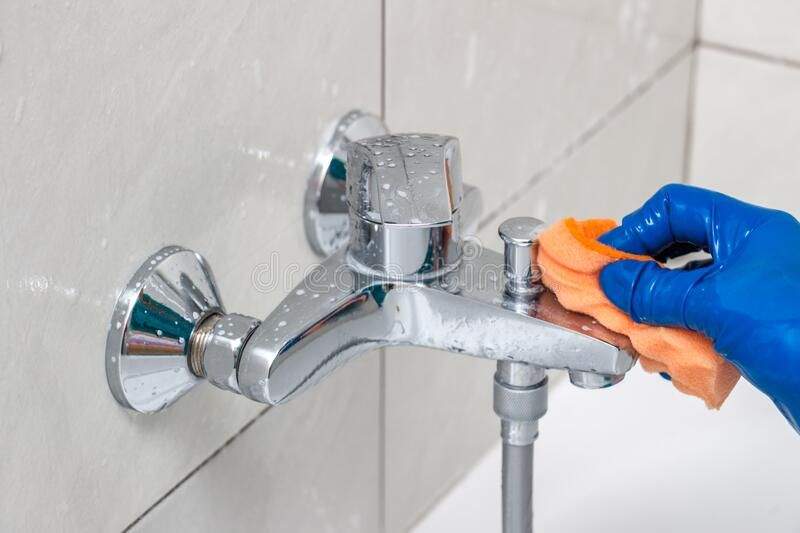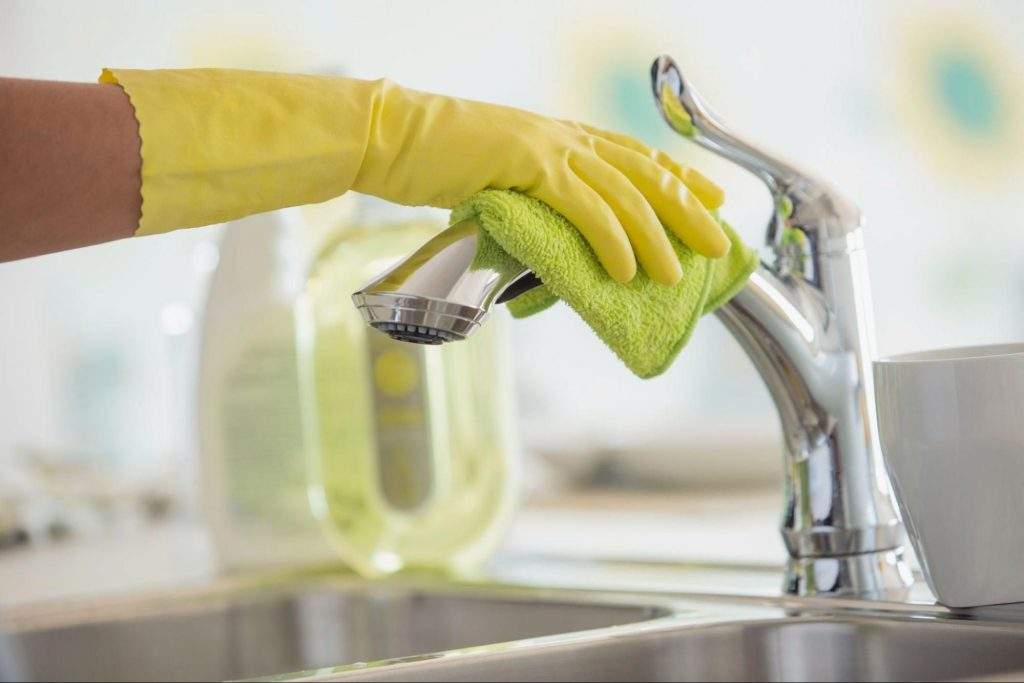Vinegar is one of the greatest cleaning agents for lime scale, green spirogyra, and hard water deposits on faucets. This content is to offer faucet cleaning tips in order to keep green buildups and dirty scales off your faucets.
Green Water Coming Out Of The Faucet

If water coming out from a faucet is completely green, algae has contaminated it due to faucet corrosion, also copper pipes leave greenish coloration as they wear. This results in accumulation of algaes in the faucet and that is why consistent cleaning with a mixture of vinegar and soda in paste form will effectively clean this. Natural bacteria called algae can develop as a clog in a filter or another area of the system over time and this is why time to time cleaning must be done to remove this.
About Green Stuff On The Faucet
A faucet’s blue-green sludge is actually “lime scale deposits.” Your tap water is “hard” due to the dissolved minerals, which leads to the formation of the lime scale, or scale deposit. You might notice pure lime scale in a tea kettle or hot pot because it is white. However, copper pipes or fixtures can cause your lime scale to turn green. Limescale is a common cause of green buildup on faucets. This is a thick layer of chalky material that covers anything that has been wet. Limescale comes in white, yellow, and green varieties. It might be white on the tub’s bottom, yellow below the sink, and green around the faucets.
Because there are more minerals in the water, it is referred to as hard water. Copper, calcium, and magnesium are among the minerals. It also turns green as copper oxide forms. One possible explanation for why a faucet can have green material on it.
Green Build-up
This is the result of water with low PH, hard water and corrosive copper pipes resulting in green deposits around sink, pipes and faucets.
Green Limescale
Hard water limescale is normally white, although it can turn discolored due to residues of other minerals or metals. Traces of copper from plumbing materials, for example, can render limescale gray, green, or blue, whilst traces of rust from pipework can color it orange, brown, or even black.
Green Deposits
Blue/green deposits around your shower, sink, and toilet drains are caused by low pH water. This indicates that the water flowing out of those fixtures is acidic, which is bad for your plumbing.
Green Calcium
When you see a bluish-green deposit on your faucet. These are calcium or limescale deposits and they are from hard water, low ph water and rustic pipes. Pesky white stains are what is known as calcium buildup.
Other Faucet Molds/Deposits/Build-ups on the Faucet
Black Gunk on the Faucet
Iron and manganese are often known for their aesthetic disaster whenever they are rustic, their reaction in a moist environment causes black gunk, film or sludge. They often appear reddish-brown at the very initial stage, later rustic brown and black consequently. Depending where the reaction occurs, you can see these gunks at the bottom of faucets or any openings.
Calcium (Deposits) On The Faucet
Calcium deposits, commonly known as limescale, form as a result of calcium salts in water. Hard water is water that has a high concentration of dissolved calcium salts. Hard water causes buildup in your plumbing system, producing deposits all over your faucets and piping.
Mineral Build-up
Because of the presence of carbon dioxide (CO2), most naturally hard water will acquire a transient hardness (calcium bicarbonate). Dissolved particles (lime) precipitate out of the water during the heating process and are deposited in the water heater tank.
Hard Water Build-up On The Faucet
Because of the presence of carbon dioxide (CO2), most naturally hard water will acquire a transient hardness (calcium bicarbonate). Dissolved particles (lime) precipitate out of the water during the heating process and are deposited in the water heater tank.
How to Remove Build-up on the Faucet (Best 6 Faucet Cleaning Methods)
This process begins with gathering the necessary cleaning agents, gloves to protect your hand, napkins, brushes and papers to act as mediums. Depending on what type of buildup you are dealing with it is appropriate to understand the chemical reactions and what suitable cleaning agent and method that would get the job done. Here are a few method to guide you through
#1 Vinegar

To remove calcium deposits from a faucet, soak a washrag in vinegar and tie it around it. When it comes to lime scale and green buildups around faucets, the capacity of diluted acetic acid to break away dirt deposits is just what you need, you should allow this to react for about 2 hours, check out this video to find out more.
#2 Lemon Juice

Citric acid is also particularly efficient in removing hard water stains and limescale; some can be removed simply by rubbing half a sliced lemon over the stain or spraying the build-up with neat lemon juice. Allow the lemon juice to rest for 10 minutes before rinsing and wiping dry.
#3 Baking Soda

In a small basin, add just enough baking soda and water to make a paste. Then, using a clean cloth, spread it all over the glass and rinse with water. Calcium buildup is ugly, but it can also cause damage to your pipes and drains. Learn from this video!
#4 Soap Dispenser

Soaps generally are great cleaning agents, considering the process of saponification, soaps are products of several agents that can actively cleanse substance off including build ups on faucets. Start by soaking these buildups with highly concentrated soap for hours and scrub afterwards with a brush.
#5 Bleach

Stop the drain, fill your sink with water, and add about a capful of bleach per gallon of water. Allow it to sit for 5 minutes. Meanwhile, clean the faucet by dipping your sponge into the bleach solution and wiping it down. On the plus side, Vim with bleach (light green container) removes rust from the toilet bowl’s little holes. Allow it to settle for a few minutes before scrubbing.
#6 Sprayer

When removing buildups from faucets irrespective of the cleaning agents you have decided to use, you can make use of a bottle spray to effectively reach every corner. Mixing sodas, bleaches and vinegar in a spray bottle is a great way to filter out green buildups or calcium deposits from hard water.
Solutions to Treat Faucet Corrosion
When magnesium, copper or low pH water start forming buildups on faucets for sinks, it is imminent to have a cool approach to curb it before it damages the faucet or even contaminates our source of water delivery.
#1 Cleaning faucet with a water softener

Installing a water softening system helps prevent your pipes from clogging further owing to hard water residual scale. As softer water runs through your pipes on a regular basis, the limescale will gradually dissolve.
#2 Using CLR on Faucet Aerator

CLR is an easy and quick way to clean your showerhead or faucet. According to experts, it is quite effective and here are simple procedures to follow:
- Submerge the showerhead in a solution of half CLR and half hot water.
- Allow it to soak in the solution for two minutes before removing the showerhead and rinsing to release the buildup inside the showerhead.
- To remove buildup, use a brush or sponge.
If required, repeat the operation with full strength CLR, rinsing carefully after each application. - Remove any debris from the aerator as well.
- Replace the shower head.
#3 Replace the Corroded Faucet (The Most Efficient Way)

When a faucet is completely damaged beyond measure and there seems to be any remedy to reviving it, it is best to consider a new means and that includes replacing it with a new one or spare in case where they are available.
Having a new faucet installed doesn’t take as much effort as many think, of course we have a common mindset of employing an expert to help us do this at the initial installation but in this case there might not be a need for that. TCK is a faucet brand that specializes in all kinds of touch and touchless faucets for bathrooms and kitchen sinks. You can check out www.oltsw.com to discover something that might spike your attention and tickle your fancy. Infrared flushers and automatic wall mounted faucet are newly explored versions of faucets that are pretty cool for replacement purposes and as well give an aesthetic look to your bathroom and kitchen.
Corrosion-Resistant Bathroom Faucet
Coatings on and within pipe systems can help reduce the rate of corrosion of buildup as opposed to pure metal faucets. Brass faucets do not break or deteriorate readily. Pure aluminum coated faucets are non-rutic. Check out the auto faucet catalog to discover amazing offerings today!
Corrosion-Resistant Kitchen Faucet
Brass faucets do not break or deteriorate readily. It is among the most corrosion-resistant materials available. This is especially critical if you have hard water running through your kitchen taps often which corrodes faucets faster than other materials, this may be due to your housing location which you might not be able to beat. You can however go for quality faucets by checking out the best kitchen faucets offerings.
How to Clean Bathroom and Kitchen Sink Faucets?
- Apply a little quantity of dish soap to a damp washcloth and lather it around until you see significant foam and bubbles forming.
- Then, just massage the cloth across the surfaces of your bathroom faucet, paying specific attention to the areas between faucet knobs. Remove the soap with water.
- Simply fill a bag with equal parts water and white vinegar,
- Submerge your kitchen faucet,
- Seal it with a rubber band or a zip tie, and your kitchen faucet should be clear of muck and running at full speed by tomorrow morning.
What to use to Clean Bathroom Sink
Most bathroom sinks may be cleaned with a soft cloth and a standard bathroom cleaning spray. To cut through filth, use mild dish detergent or distilled white vinegar combined with water. Lemon juice, baking sodas, vinegar, bleach and special aerosols are often used for bathroom faucet cleanings.
How to Clean Faucets
Cleaning up a faucet with lime scale or green buildup might be somewhat stressful.
- After gathering your supplies,
- Clean the faucet’s exterior:
- Soak several paper towels or rag strips in white vinegar.
- Wrap them around all of the faucet’s trouble spots and secure them with rubber bands. Allow them to rest for at least an hour.
- Then, using a moist sponge or towel, clean the faucet.
Conclusion
If you use anything other than water to clean the faucet, you will remove some or all of the patina. If you enjoy the patina, try not to scrape it off. Also using hard brushes on faucets that are yet corrosive can lead to damage. This is why it is very important to be aware of how well to take care of your faucet and I believe this content has cleared a lot of doubt.
